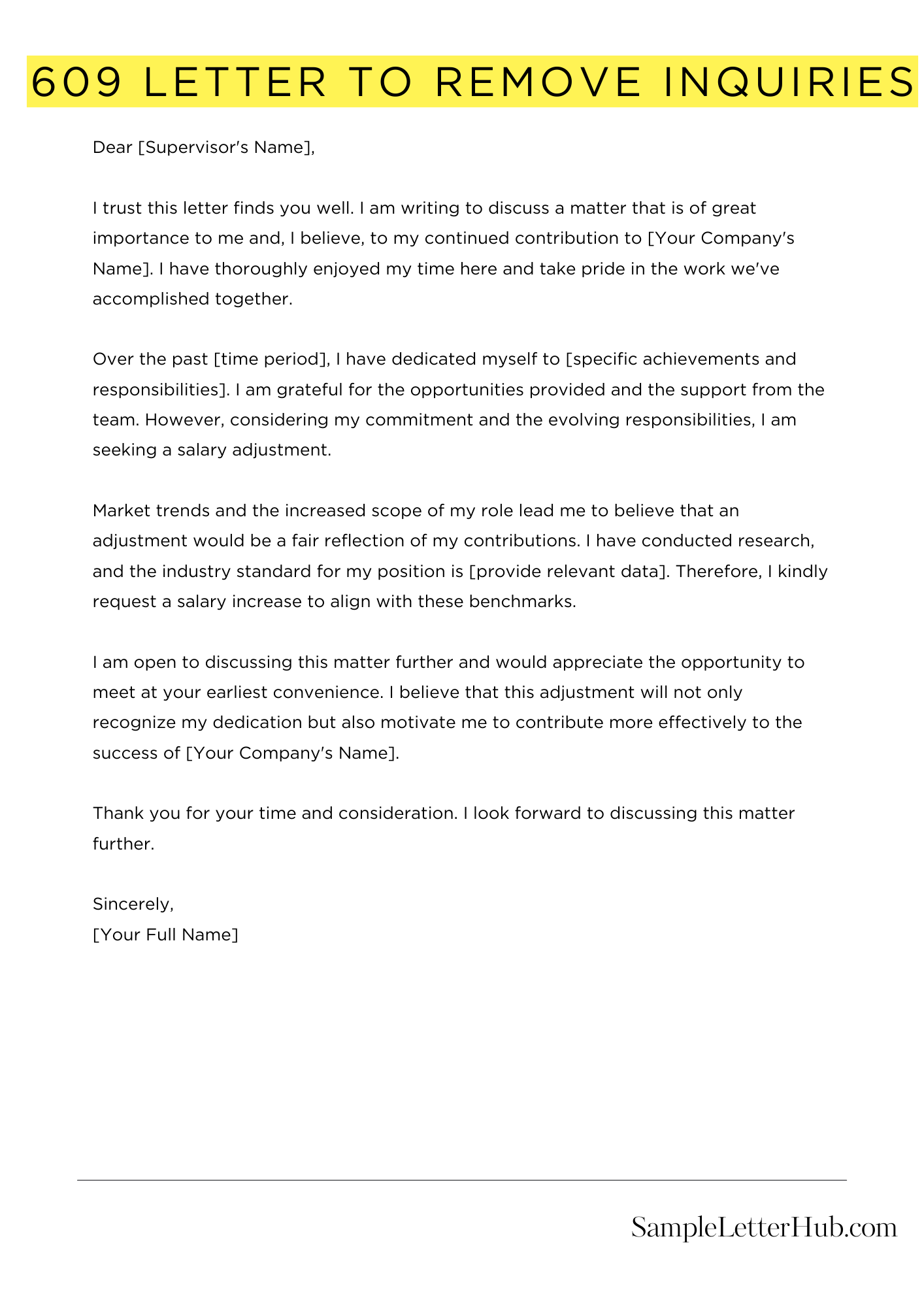A 609 Letter To Remove Inquiries is a letter you can send to credit bureaus to request the removal of inquiries from your credit report. Inquiries are made when you apply for new credit, and they can stay on your report for up to two years. Too many inquiries can lower your credit score, so it’s important to remove any that are inaccurate or unnecessary.
In this article, we’ll provide you with templates and examples of 609 Letters To Remove Inquiries. These letters will help you to write your own letter and get the inquiries removed from your credit report.
609 Letter to Remove Inquiries
Dear [Credit Bureau Name],
I am writing to request the removal of several inquiries from my credit report. These inquiries were made without my authorization and are negatively impacting my credit score.
The following is a list of the inquiries I am requesting to be removed:
* [Inquiry 1 Date] – [Inquiry 1 Source]
* [Inquiry 2 Date] – [Inquiry 2 Source]
* [Inquiry 3 Date] – [Inquiry 3 Source]
I have attached copies of my credit report showing these unauthorized inquiries. I have also included a copy of my driver’s license for identification purposes.
I understand that inquiries can remain on a credit report for up to two years. However, I believe that these inquiries should be removed because they were not authorized by me.
I request that you investigate this matter promptly and remove the unauthorized inquiries from my credit report. I appreciate your attention to this matter.
Sincerely,
[Your Signature]

How to Write 609 Letter To Remove Inquiries
A 609 letter is a letter that you can send to the credit bureaus to request that they remove inaccurate or outdated information from your credit report. This can be a helpful way to improve your credit score and make it easier to get approved for loans and other forms of credit.
To write a 609 letter, you will need to include the following information:
- Your name and address
- The name and address of the credit bureau that you are writing to
- The date
- A brief explanation of why you are disputing the information on your credit report
- Copies of any supporting documentation that you have
Once you have gathered all of the necessary information, you can begin writing your letter. The letter should be clear and concise, and it should be written in a professional tone. You should also be sure to proofread your letter carefully before sending it.
Once you have written your letter, you can mail it to the credit bureau. You should also keep a copy of the letter for your records.
The credit bureau has 30 days to investigate your dispute. If they find that the information on your credit report is inaccurate or outdated, they will remove it. If they find that the information is accurate, they will send you a letter explaining their decision.
If you are not satisfied with the credit bureau’s decision, you can file a complaint with the Consumer Financial Protection Bureau (CFPB). The CFPB can investigate your complaint and help you resolve the issue.
FAQs about 609 Letter To Remove Inquiries
What is a 609 letter?
A 609 letter is a dispute letter that you can send to credit bureaus to request the removal of inaccurate or unverifiable negative items from your credit report.
What information should I include in a 609 letter?
Your 609 letter should include your name, address, contact information, the name of the credit bureau you are disputing with, the account number(s) of the disputed items, and a copy of your credit report.
How do I send a 609 letter?
You can send a 609 letter by mail or online. If you send it by mail, you should send it certified mail with return receipt requested.
What happens after I send a 609 letter?
The credit bureau has 30 days to investigate your dispute. If they find that the disputed items are inaccurate or unverifiable, they must remove them from your credit report.
What if the credit bureau does not remove the disputed items?
If the credit bureau does not remove the disputed items, you can file a complaint with the Consumer Financial Protection Bureau (CFPB).

